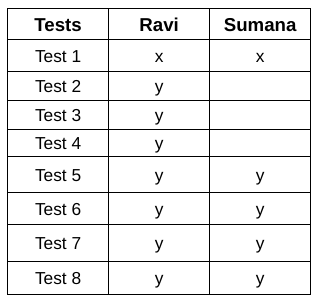Read the following scenario and answer the THREE questions that follow.
Comprehension:
In an 8-week course, a professor administered a test at the end of each week. Each of the eight tests was scored out of 4 marks, and a student could only receive a non-negative integer score.
Two students, Ravi and Sumana, took the eight tests.
In the first test, Ravi and Sumana scored the same marks. From the second to eighth tests, Ravi scored the exact same non-zero marks. Sumana scored the same marks as Ravi from the fifth test onwards. Ravi’s total marks in the first three tests was the same as Sumana’s total marks in the first two tests. Also, Sumana’s marks in the first test, total marks of the first two tests, and total marks of the eight tests are in a geometric progression.
Solution
According to the set, there are 8 tests and each test can have a maximum of 4 marks so any student can get a maximum of 32 marks.
Now, the number of marks received by any student in a test can be 0/1/2/3/4.
We are given information about two students, Ravi and Sumana.
In the first test, they both scored the same marks. Let the marks scored by both is $$x$$.
Further, from the second to eighth tests, Ravi scored the exact same non-zero marks. Let the marks scored by Ravi from second to eighth test is $$y$$ where y can be 1/2/3/4. Also, Sumana scored the same marks as Ravi from the fifth test onwards.
With this, we get the following table:

Ravi’s total marks in the first three tests was the same as Sumana’s total marks in the first two tests.
Let the marks of Sumana in the second test be $$z$$.
We are given that, $$x\ +\ 2y=x+z$$
Therefore, we can say, z = 2y.
We don't have any other information about their marks in specific tests so let the marks of Sumana in test 3 and test 4 be $$a$$ and $$b$$ respectively.
With this, we have:

At last, we are given that Sumana’s marks in the first test, total marks of the first two tests, and total marks of the eight tests are in a geometric progression.
i.e. x, (x + 2y) and (x + a + b + 6y) are in a geometric progression.
With this, we can infer that x can't be 0 as if x is 0, any number multiplied with it will be 0 and (x+2y) and (x + a + b + 6y) can't be in a geometric progression.
Hence, x can be 1 / 2 / 3 / 4.
Let's try to make all possible geometric progression with this information:
1. (1, 3, 9) when x = 1, y = 1 and a + b = 2
2. (2, 4, 8) when x = 2, y = 1 and a + b = 0
3. (2, 6, 8) when x = 2, y = 2 and a + b = 4
4. (4, 8, 16) when x = 4, y = 2 and a + b = 0
In the question, we need to answer which of the mentioned statements can be true:
A: Ravi scored 4 marks in the third test
y can't be 4 in any of the possible case. Hence, the statement can't be true.
B: Sumana scored 2 marks in the first test
Sumana scored x marks in the first test and x can be 2. Hence, this can be true.
C: Ravi scored 0 marks in the fifth test
y can't be 0 as we discussed above. Hence, this statement can't be true.
D: Sumana scored 3 marks in the second test
Sumana scored 2y in the second test and if 2y = 3, y will be a non integer number which is not possible.
E: Sumana scored 4 marks in the eighth test
y can't be 4 in any of the possible case. Hence, this can't be true.
Create a FREE account and get:
- All Quant Formulas and shortcuts PDF
- 15 XAT previous papers with solutions PDF
- XAT Trial Classes for FREE
